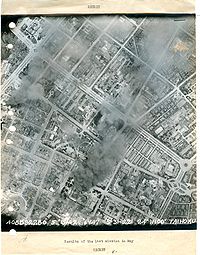Raid on Taihoku
| Taihoku Air Raid | |||||||
|---|---|---|---|---|---|---|---|
| Part of World War II, Pacific theater | |||||||
 An aerial photograph by U.S. Air Force |
|||||||
|
|||||||
| Belligerents | |||||||
|
|
|
||||||
| Strength | |||||||
| Virtually nonexistent | 117 B-24 | ||||||
| Casualties and losses | |||||||
| Civilians killed: 3,000+ Wounded/Displaced: tens of thousands |
none | ||||||
The Taihoku Air Raid (traditional Chinese and Japanese: 臺北大空襲; ; pinyin: Táiběi Dà Kōngxí; rōmaji: Taihoku Daikūshū) that took place on 31 May 1945 was the largest Allied air raid on the city of Taihoku (modern-day Taipei) during World War II. Despite efforts by Allied planners to minimize civilian casualties, many residents were killed in the raid and tens of thousands wounded or displaced.
As early as 1943, Fourteenth Air Force of the United States Army Air Forces and units of the combined air force of U.S. and Nationalist China had launched several air raids against military and industrial targets in Japanese Taiwan. Before this, Soviet volunteer units and Chinese air force had attacked military bases around Taihoku, most of which were targeted on smaller objectives and were of smaller scales. After American ground forces captured Subic Bay in the Philippines, the Allied air forces began larger and more systematic air raids against targets on the island of Taiwan. After October 12, 1944, Allied air forces began scheduled air raids on factories located in Heitō (Pingtung) and Kobi (Huwei), Takao Harbor (Port of Kaohsiung), and fighter production facility in the outskirt of Takao (Kaohsiung). Also, Taihoku, the capital and political and financial center of Taiwan, had been under constant aerial assaults by the Allies since that time.
...
Wikipedia
